Hearing Aids
What is in a Hearing Aid?
There are many hearing aids available with different shapes, sizes, styles, colors, and features. However, all hearing aids need certain components to transmit sound from the environment into your ear. Essential parts include a microphone, an amplifier, a receiver, and a battery. See the image below.
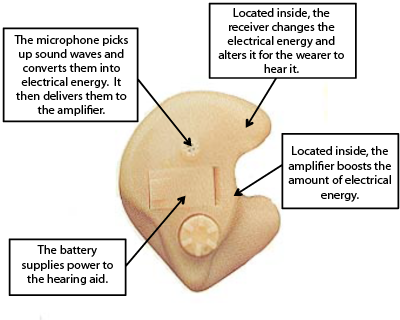
What hearing aid is right for you?
There are several important factors to consider when purchasing hearing aids. These factors include, but are not limited to, the type and severity of your hearing loss, your hearing needs and desires, your lifestyle, cosmetic concerns, your previous experience with hearing aids, and your budget. This is not an easy decision to make. Your audiologist will guide you in the process of selecting hearing aids that are best fit for you.
What are the differences in hearing aids?
While all hearing aids have the same basic components, they vary in many ways. Consider comparing hearing aids to other electric devices that you have purchased in the past, such as a television. All televisions have various levels of technology to choose from. Hearing aids range from entry level (basic) to advanced. With each advance in technology comes an increase in the price. In other words, the more "bells and whistles" hearing aids have, the more expensive they will be. Remember, hearing aids are not for entertainment purposes, but to help compensate for a loss that you have and improve your quality of life. This may impact your decision of which level hearing aids you choose to purchase.
Hearing Aid Styles
Hearing aids come in a variety of sizes, colors, types, and technology. The two basic hearing aid styles are Behind-The-Ear and In-The-Ear. Not all hearing aid styles are appropriate for every type and magnitude of loss. For example, if you have a profound hearing loss, Completely in the Canal (CIC) hearing aids are not the appropriate style for you. Below is a description of each style, along with some advantages and considerations when choosing a hearing aid.
Open Fit
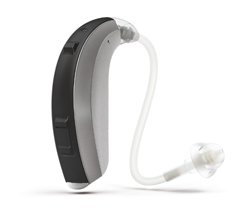
Open fit hearing aids are relatively new to the market. They are appropriate for individuals with a mild to moderate high frequency hearing loss (normal hearing in the low frequencies). This style hearing aid leaves the ear canal open, or unoccluded.
Advantages:
- Reduction in the occlusion effect (occlusion effect: when your ears are plugged up, it can sound as if you head is "in a barrel," and/or your own voice may sound "hollow.")
- Increased comfort
- Good sound quality
- Less noticeable than other styles
Receiver in the Ear (RITE)

RITE hearing aids are similar to open fit hearing aids, but they have the receiver in the ear canal instead of in the case of the hearing aid. By placing the receiver in the ear canal, it allows the hearing aid to be smaller.
Advantages:
- A smoother frequency response can occur because the receiver is in the ear canal
- Appropriate for individuals with a wider range of hearing loss compared to open fit hearing aids, due to a wider frequency fitting range
- They can be fit for individuals who have a hearing loss in the low and high frequencies
Remote Microphone
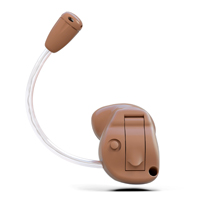
Remote microphone hearing aids are also relatively new to the market. Similar to the open fit design, this style hearing aid is not appropriate for every type and magnitude of hearing loss.
Advantages:
- The hearing aid sits in the curve of the ear, with no part of the instrument behind the ear
- The ear canal is left unoccluded
- The microphone is positioned in such a way to take advantage of the natural contours of the ear
Behind the Ear (BTE)
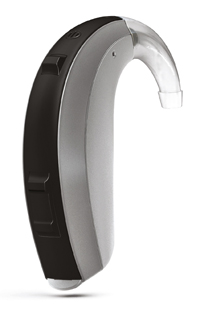
The electrical components of the instrument (microphone, amplifier, receiver) are housed in a compact case that tucks behind the ear. Sound is delivered to the ear canal through a clear tube over the top of the ear and into a custom-made acrylic/silicone earmold.
Advantages:
- Most come standard with a telecoil switch (reduces interference on the telephone and is compatible with loop systems in many auditorium halls)
- Available in a variety of colors to blend with skin or hair
- Provides the best performance for severe hearing losses
- Extremely sturdy and reliable; also highly recommended for children
- Typically uses a larger battery (size 675 or 13) for longer battery life and easier manipulation
- Larger controls that are easier for some people to adjust
Considerations:
- Requires the ability to insert earmold and to control telephone switch
- Earmold needs regular maintenance and may need yearly replacement
In-The-Ear (ITE)
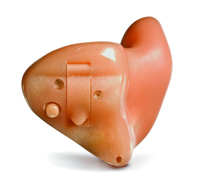
Electrical components of this instrument (microphone, amplifier, receiver) fit into a shell custom made to fit inside the ear. An ITE device may be more visible in the ear, though there are several types of ITE hearing aids, such as a Compeltely in the Canal (CIC), and In the Canal (ITC).
Advantages:
- More space for venting to reduce the occasional sensation of occlusion so your own voice will sound better
- Somewhat larger and can be easier to handle.
- Optional telecoil switch
In the Canal (ITC)
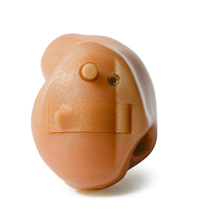
The canal style provides a very cosmetic solution that can be hidden in most ears.
Advantages:
- Uses a slightly larger battery(size 312) than the CIC for battery economy
- Optional telecoil switch
Completely in the Canal (CIC)
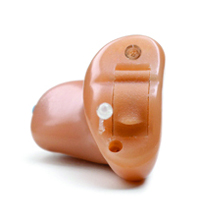
The completely-in-the-canal is the smallest style available.
Advantages:
- Excellent cosmetics-- almost invisible in the ear
- Comfortable and convenient telephone usage
- Takes advantage of the ear's own natural sound-collecting design
- Less wind noise
Considerations:
- Uses a very small battery(size 10) that requires good manual dexterity
- Battery life is typically about one week
- CIC style may not be suitable for all hearing losses or ear sizes
- Collects ear wax/blockage more than other styles since it fits further down in the ear canal; it is therefore more susceptible to breaking down and needing repair
Technology of Hearing Devices
Thanks to electronic technology, many features are available for hearing devices. First, there are the conventional hearing aids. Conventional hearing devices use basic analog technology to provide amplification. With an analog device, sound waves enter through the microphone, are amplified by a chosen circuit, pass through the receiver, and go out into the ear as sound waves. With this technology, the user has volume control, but there is limited fitting flexibility. Conventional hearing aids represent the most basic type of amplification and are a good choice when finances are the major concern.
Next, there are the programmable hearing aids. Programmable hearing devices feature conventional amplifiers and filters controlled by an external digital source. Other terms used to describe this mode of operation include: digitally programmable and analog hearing aids with digital control. Some programmable systems allow little or no control of the hearing aid characteristics by the hearing aid wearer, whereas others allow the wearer to control performance in certain environments via a remote control carried with them. This device delivers a more natural loudness throughout the wearer's entire listening range without getting too loud or too quiet, as can be the case with conventional hearing aids.
Finally, the most advanced and most widely used today is the 100% digital hearing aids. In digital hearing devices, sound waves entering the microphone are converted into digital format. They are then separated into different frequency bands and channels and converted back to analog format out into the ear canal as a sound wave. Digital hearing aids are distinguished from programmable hearing aids in at least three ways: 1) the input signal is digitized; 2) digital signal processing circuitry (DSP chip) is used in the hearing aid; and 3) they can be designed to "make decisions." The hearing aid will adjust according to the sound environment the user is in. For example, the hearing aids process speech and recognize noise to enhance your listening environment. The sophistication of the algorithm used in the hearings aids varies between levels of technology. These devices are controlled and programmed by an audiologist with a computer.
Overall, the more sophisticated the hearing aids, the better user performance and therefore satisfaction. The cost will reflect the level of technology that the hearing aids incorporate.
Hearing Aid Features
There are many optional features that are available to order on hearing aids. Keep in mind that you do not need every feature! It is important to discuss with your audiologist what is right for you and your lifestyle. The lowest level of technology usually has the least amount of standard features, while the highest level of hearing aids have the most standard features. Some features to consider:
- Number of programs/memories
- Bands and channels
- Directional microphones
- Feedback management
- Compression
- Expansion
- Noise reduction
- Remote controls
- Automatic operation
- Bluetooth and wireless technology
- Telecoil
- Easyphone, East FM
- Direct Audio Input
- Warranties
Programs/Memories
Hearing aids can have up to several programs, or "memories." Inside the hearing aids, the circuits work differently in order to maximize the benefit you receive in each listening situation. Different internal settings of hearing aids are optimal for different listening situations. There are many programs to choose from. Examples include: quiet, noise, music, cards, concerts, restaurants, etc.
Programs can be changed manually by the push of a button, or the hearing aids can adjust to your listening environment automatically. Hearing aids will alert you when a program is changed by signaling a number of beeps (corresponding to the number position spot of the program), or they may be able to use a verbal messaging system that will "speak" to you, indicating which program the hearing aids are operating in. The verbal messaging system may be set to a variety of languages.
The number of available programs depends on the manufacturer and level of hearing aids you choose to purchase. Every manufacturer has instruments in every level of sophistication.
Bands and Channels
A band refers to a frequency region where gain (loudness) adjustments are made. The amount of gain applied differs with each band, dependent on your hearing loss.
A channel refers to a frequency region where the same signal processing takes place. A channel incorporates a broader frequency region. It can be thought of as the background in signal processing.
The audiologist manipulates the bands to influence the algorithms and signal processing in the hearing aids. This allows for flexibility and fine tuning.
You can think of bands and channels in hearing aids as the keys and strings on a piano: the white keys represent the channels, and the black keys represent the bands.

The more channels hearing aids have, the more natural the sound quality will be to a patient; just as the more keys on a piano, the more increase in sound quality for the listener. Therefore, more bands and channels can help improve speech recognition. As the number of available bands and channels increases, so does the cost.
Directional Microphones
A conventional hearing aid microphone is also called an omnidirectional microphone. As long as there are no significant objects nearby to reflect or diffract a sound, an omnidirectional microphone will respond equally to the sounds from any direction. In other words, the microphone is equally sensitive to all incoming sounds, regardless of the direction of the sounds. No sounds are reduced in relation to others. Omnidirectional microphones are used best in quiet listening environments.
A polar pattern is a plot of a device's sensitivity or efficiency as a function of the angle around the device in 360°. For an omnidirectional microphone, the polar plot shows the microphone is equally sensitive in all angles. The farther from center a point on the graph is, the stronger the microphone's signal is at that angle.
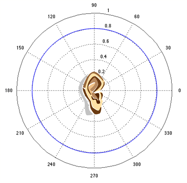
One of the best ways to improve speech recognition in a noisy environment is the use of a directional microphone (DM). In general, DMs are more sensitive to sounds from some directions than others. Traditionally, these microphones pick up and amplify sounds coming from the front of the wearer and attenuate the sounds from the side and behind the wearer. Therefore, DMs can help the wearer when listening in background noise.
A DM is the only hearing aid option that can improve your speech recognition in noise by improving the Signal to Noise Ratio (SNR). The SNR is the ratio of the desired signal's volume to the unwanted "noise," measured in decibels (dB). The ability to understand speech depends on how much of the signal can be heard in the background noise. People with a hearing loss require 5-15 dB better SNR than those with normal hearing to equally understand speech in noise. DMs can improve SNR by 4-5 dB.
Now, let us refer to more complicated polar patterns to help us understand how DMs amplify and attenuate signals, or help improve your SNR. All plots shown here are to be visualized as if your head was looking forward. All are better in some noisy situations than others and the four shown below are considered the most common. In all plots, 0° is in the front, 90° and 270° are the sides (right/left), and 180° is in the back.
Cardioid Polar Pattern
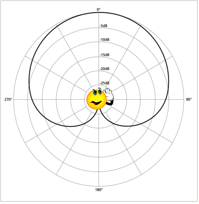
This pattern is characterized by strong sensitivity (more amplification) to signals from the front, good sensitivity on the sides, and almost complete rejection of sound signals from behind the hearing aid wearer.
Theoretically, this pattern offers the most benefit when the signal of interest is in the front, and the noise is behind you.
In the real world, noise can come from all directions!
Bi-Directional Polar Pattern
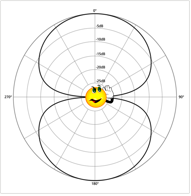
Also referred to as di-pole or a Figure 8, this microphone pattern is virtually equally sensitive (equal amplification) to sound signals from the front and back, but not sensitive to sounds from the sides.
Hypercardioid Polar Pattern
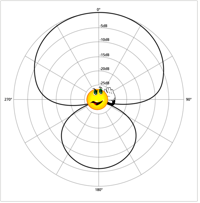
This pattern is characterized by a strong sensitivity (more amplification) to sound signals from the front, minimal at the sides, and a slight amplification to sound signals originating from behind the hearing aid user.
Supercardioid Polar Pattern
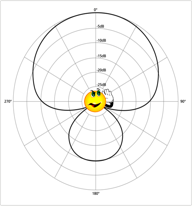
Similar to the hypercardioid polar pattern, this pattern is characterized by strong sensitivity (more amplification) to sound signals from the front, minimal at the sides, and a very slight (even less than hypercardioid) amplification to sound signals originating from behind the hearing aid user.
As with all features, there are levels of technology within the design of directional microphones. As the technology increases, so does the price. The most simple is called fixed directional. Fixed directional works best when noise is in a fixed mode (one polar plot that does not change). The next is called adaptive directional. Here, the hearing aids use more than one polar plot and change based on where the noise is coming from. The patient must manually switch between omnidirectional and directional modes. Then, there is automatic adaptive directional. This is similar to adaptive directional, but switches automatically. When there is a single sound source, the microphones stay in omnidirectional mode and switch to directional mode when there is more than one sound source. Finally, the most advanced system uses automatic adaptive multichannel directional. The microphones have polar plots for the different frequency bands (see Bands and Channels) and analyze the spectrum of the signal and adjust accordingly.
Feedback Management
Feedback is a common problem with hearing aids that results in a whistling noise. It may be caused by the user's ear, the fit of the hearing aid to the ear, and/or the hearing aid itself. During the fitting process, a measurement is made of how much amplification can be given at each frequency without feedback occurring. This system ensures that the amplification can never be increased enough to cause whistling. Feedback managers range in their level of technology from simple single channel to advanced multichannel systems.
Compression
Do you find it difficult to hear certain soft sounds, but loud sounds are often overwhelming or uncomfortable? Compression is used in order to ensure audibility of sounds while maintaining recognition and comfort for medium and loud level sounds. This feature acts like an automatic volume control for different frequency bands. It produces high gain for low input levels of sound and lower gain for high input levels of sounds.
Hearing aids having various levels of technology perform this task differently. For example, linear hearing aids do not use compression at all. They apply the same amount of gain (increase in volume) to all incoming signals. Hearing aids that employ compression limiting apply the same amount of gain to all signals up to a certain input level. Above this, reduction occurs. The various levels of hearing aids have compression circuits that work differently depending on:
- Attack and release time: how long it takes for compression to start and then stop
- If the release times are dependent on the length of attack signal (utilizing adaptive compression)
- Number of compression channels that operate independently
Expansion
Expansion is the opposite of compression. It produces low gain for low levels of sounds and high gain for high levels of sounds. It adds broadband gain of the spectrum of the input signal level to help overcome internally generated noise. Expansion is often a useful feature when the hearing aid user enters a reverberant environment.
Noise Reduction
Hearing aids with noise reduction capabilities change their frequency gain characteristic as a result of analysis of the incoming signal (speech vs. noise). Various noise reduction strategies can be used to reduce ambient noise. Hearing aids work to determine a signal as noise and then reduce this signal. The use of noise reduction helps improve listening comfort in noise. Typically, manufacturers employ more than one noise reduction strategy for their hearing aids.
Sophisticated algorithms are used to estimate the nature of the signal and determine it as noise rather than speech. Each hearing aid manufacturer has a different approach to do this. Once it is determined that a signal is noise, gain adjustments across frequencies can be made. While the same basic premise is true of all hearing aids with noise reduction, there are levels of technology within this feature.
Noise reduction technology differs in hearing aids, depending on:
- The number of channels in the hearing aids
- The level at which noise reduction becomes active
- The maximum amount of gain adjustment made across frequencies
- Speed at which the filter changes its frequency response characteristics
So, the most advanced hearing aids have a noise reduction algorithm that is better at recognizing a signal as noise, acts quickly upon reducing the noise, and makes frequency-specific gain adjustments across multiple channels.
Remote Controls
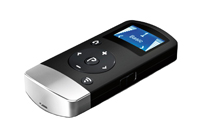
Like other electronic devices, hearing aids can come with a remote control. Remotes can be used to adjust the volume, change programs, switch between modes (microphones, telecoil), and may indicate battery status. The most recent advancement in technology allows the hearing aid user to change the polar plot (see directional microphones) design of their microphones through a remote. Remotes can be pocket-sized, can attach to a keychain, or can be built into a watch. One manufacturer allows you to change volume and programs by using the telephone keypad.
Automatic Operation
The degree of automatic operation that a hearing aid user chooses to have should be dependent on the amount of control they desire. It is possible to have your hearing aids do everything for you from the moment you turn them on. This includes adjusting the volume, changing programs, and changing modes (microphone, telecoil). If you want your hearing aids to be fully automatic or "hands-free", this indicates a high level of technology. Therefore, the hearing aids will be more expensive. Fully automatic hearing aids constantly monitor the listening environment you are in and make adjustments accordingly in order to provide maximum user benefit.
Bluetooth Technology
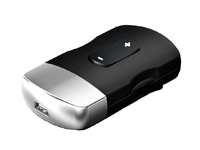
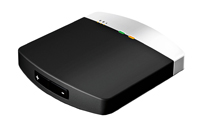
Bluetooth technology is short-range wireless radio technology that allows electronic devices to connect to one another. Bluetooth technology can be used for cross communication where sound processing is synchronized between your two hearing aids. Both hearing aids communicate in order to adjust to your listening situation and ensure balance between the ears. One control or push button on the hearing aid or remote can be used to adjust both hearing aids at the same time.
Bluetooth compatible devices include: hearing aids, mobile phones, MP3 players, FM devices, and televisions. A digital Bluetooth signal is extracted from the noise. This means that the signal alone is transmitted and amplified while noise is rejected, resulting in a clear signal. These products allow wireless connection between your hearing aids and other communication and entertainment devices.
Telecoil
A telecoil is a small coil inside of a hearing aid that acts as a magnetic field sensor. The telecoil also senses any oscillating magnetic field (for FM system and other assistive listening devices).
When the hearing aids are in the telecoil mode (T), the microphone (M) is not being used. Therefore, environmental sounds are eliminated. In the telecoil mode, hearing aids only pick up sounds from the magnetic field that they sense, such as a telephone or FM system. Some hearing aids also have a microphone and telecoil (M+T) setting in order to receive acoustic and magnetic energy simultaneously.
Some hearing aids have a programmable telecoil. This means that the telecoil can be manipulated in terms of strength or loudness. It can be adjusted to provide the hearing aid user with a maximized signal. Telecoils can also be manual or automatic. A manual telecoil requires the user to change to the telecoil (T) mode by using a toggle switch on the hearing aid or with a remote control. An automatic telecoil will automatically switch from microphone to telecoil mode when near an electromagnetic source.
When using the telecoil, the common problem of feedback is eliminated.
Easyphone/Easy FM
This feature automatically recognizes when there is a magnetic field and adjusts accordingly, switching to the telecoil setting to pick up this type of energy. For example, when the hearing aid user picks up the receiver of a telephone, the hearing aids will switch into telecoil mode without having to press a button. The same can be done for use with an FM system or other assistive devices that use electromagnetic energy.
Direct Audio Input
This feature allows for direct connection to other devices such as assistive listening devices, televisions, computers, MP3 players, radios, etc. The signal is routed directly into the hearing aids from other devices. Assistive listening systems and other hearing assistive technologies can be of great benefit when either working separately from, or in combination with, your hearing aids.
Warranties
Warranties vary in duration and therefore also vary in price. Considering how much hearing aids may cost, it is often worthwhile to have a longer warranty period, or extend it if possible. If you lose or damage your hearing aids when the warranty has expired, replacement and repair can be quite pricey.


